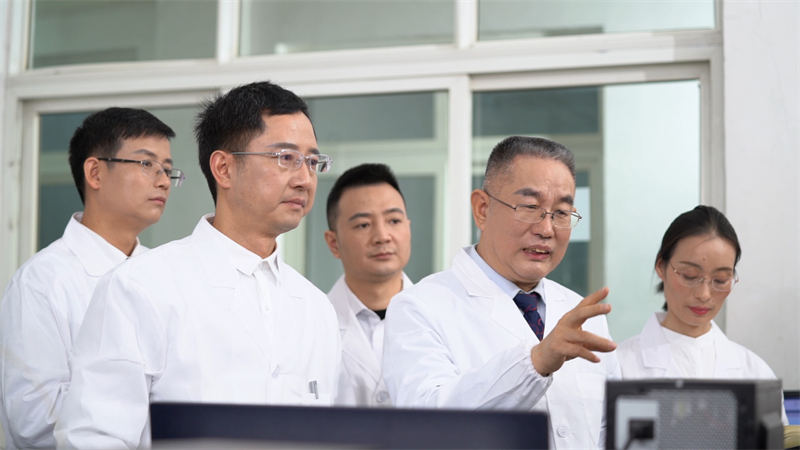Introduction
Solid phase peptide synthesis (SPPS) is a fundamental technique in the field of biochemistry and chemistry. It revolutionized the way researchers and scientists produce peptides and proteins. In this comprehensive article, we will delve into the principles, methods, and applications of SPPS, providing a detailed understanding of this essential tool for modern molecular biology research.
I. Historical Perspective
Solid phase peptide synthesis has a rich history dating back to the early 1960s when Robert Bruce Merrifield introduced the concept of synthesizing peptides on a solid support. Merrifield’s groundbreaking work earned him the Nobel Prize in Chemistry in 1984. His innovative approach involved attaching the C-terminus of the growing peptide chain to a solid resin, enabling the stepwise assembly of peptides.

II. Principles of SPPS
A. Protecting Groups One of the critical aspects of SPPS is the use of protecting groups to selectively mask functional groups. Common protecting groups include Boc (tert-butoxycarbonyl) and Fmoc (fluorenylmethoxycarbonyl). These groups prevent unwanted reactions during peptide synthesis.
B. Resin Support Solid phase peptide synthesis relies on a solid resin support to anchor the growing peptide chain. Polystyrene-based resins are commonly used due to their stability and versatility.
C. Coupling Reagents Activation of amino acids and coupling with the growing peptide chain is achieved using coupling reagents like DIC (diisopropylcarbodiimide) or HBTU (2-(1H-benzotriazole-1-yl)-1,1,3,3-tetramethyluronium hexafluorophosphate). These reagents facilitate amide bond formation.
D. Cleavage After the peptide is fully assembled, it is cleaved from the resin. Common cleavage methods involve the use of strong acids like trifluoroacetic acid (TFA) or hydrogen fluoride (HF).
III. SPPS Steps
A. Loading the Resin SPPS begins by attaching the first amino acid to the resin. This is often accomplished by using a linker molecule.
B. Chain Elongation The iterative process of SPPS involves adding amino acids one by one, starting from the C-terminus and proceeding to the N-terminus. Each amino acid is protected, deprotected, and coupled in a stepwise fashion.
C. Cleavage and Deprotection Once the peptide is fully synthesized, it is cleaved from the resin and deprotected. This yields the crude peptide, which can then be purified and characterized.
IV. Applications of SPPS
A. Peptide Synthesis SPPS is widely used for the production of synthetic peptides, which find applications in various fields, including drug development, vaccine design, and biochemical studies.
B. Peptidomimetics SPPS allows for the creation of peptidomimetics—molecules that mimic the structure and function of peptides but offer improved stability and bioavailability.
C. Protein Engineering SPPS can be used to synthesize short protein fragments or domains for studying protein structure and function. It also plays a role in protein engineering for designing novel proteins with tailored functions.
D. Drug Discovery SPPS is a crucial tool in the development of peptide-based drugs, including peptide hormones, enzyme inhibitors, and antimicrobial peptides.
V. Advances in SPPS
A. Automation Automation has streamlined the SPPS process, increasing its efficiency and accuracy. Modern peptide synthesizers can handle multiple reactions simultaneously, reducing synthesis times.
B. Chemoselective Reactions Advancements in chemoselective reactions allow for the introduction of specific functional groups at desired positions in the peptide chain.
C. Solid-Phase Native Chemical Ligation This technique combines SPPS with native chemical ligation to produce large and complex peptides and proteins.
VI. Challenges and Future Prospects
A. Side Reactions Despite its many advantages, SPPS can still suffer from side reactions, including racemization and aspartimide formation. Ongoing research focuses on minimizing these issues.
B. Expanding the Chemical Space Researchers are exploring new chemistries and building blocks to expand the chemical diversity of synthesized peptides.
C. Bioconjugation The integration of bioconjugation techniques with SPPS enables the attachment of peptides to other molecules, opening up new possibilities for targeted drug delivery and diagnostics.
Conclusion
Solid phase peptide synthesis has been a cornerstone of peptide and protein research for decades. Its principles, methods, and applications continue to evolve, making it an indispensable tool for scientists in various fields. As our understanding of SPPS deepens and its techniques advance, the potential for groundbreaking discoveries in biology, medicine, and beyond becomes even more promising.
Chengdu Shengnuo Biotechnology Co., Ltd., established in July 2001, is located in Dayi County, Chengdu City, with a registered capital of 60 million yuan. Its wholly-owned subsidiary is Chengdu shengnuo biopharmaceutical Co., Ltd. From the initial registered capital of 1 million, to the current total assets of 250 million, the company has achieved sound and rapid development. With “Chengdu polypeptide drug engineering technology research center”, sinobio has passed the FDA certification of the United States, and has become a professional polypeptide drug and product development, technology transfer, technical services, large-scale production and export of peptide medicine industrial park.
Other Polypeptide APIs Products
peptide synthesis companies
| Polypeptide APIs Products |
| US-DMF LIST |
| Beauty peptides |
| Chinese cGMP APIs |
| Mexico Registered APIs |
| Research Peptide APIs for Regulatory Market |
| Polypeptide Preparation |
| Kaijie bio medicine Peptide APIs |